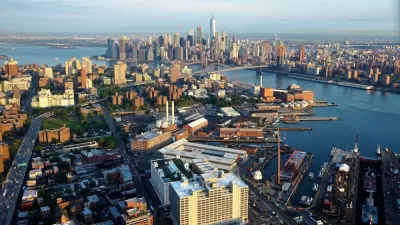The message from last weekend's two-day symposium at Columbia University, the Queens Museum and the Museum of the City of New York on Robert Moses: many aspects of the master builder's place in history haven't been told, despite Robert Caro's 1,162-page Pulizter Prize-winning biography; and that New York may need to rethink the paradigm for big plans and community engagement as the unique metropolis makes new investments in transit, roadways and large redevelopment projects from Ground Zero to Hudson Yards.
The message from last weekend's two-day symposium at Columbia University, the Queens Museum and the Museum of the City of New York on Robert Moses: many aspects of the master builder's place in history haven't been told, despite Robert Caro's 1,162-page Pulizter Prize-winning biography; and that New York may need to rethink the paradigm for big plans and community engagement as the unique metropolis makes new investments in transit, roadways and large redevelopment projects from Ground Zero to Hudson Yards.
"Robert Moses: New Perspectives on the Master Builder" featured 21 presentations of papers from leading thinkers in planning and academia, many of which informed the well-visited trifecta of exhibitions, Robert Moses and the Modern City. The three concurrent exhibitions are Robert Moses and the Modern City: Remaking the Metropolis, at the the Museum of the City of New York www.mcny.org; Robert Moses and the Modern City: The Road to Recreation, at the Queens Museum of Art www.queensmuseum.org; and Robert Moses and the Modern City: Slum Clearance and the Superblock Solution at the Wallach Gallery at Columbia University www.columbia.edu/cu/wallach.
Ray Bromley from the University of Albany/SUNY had the heretical suggestion that the Cross-Bronx Expressway isn't as bad as roadways in places like Detroit, and may not have been the single cause of decline in the South Bronx. Jeffrey Kroessler from the John Jay College of Criminal Justice examined a project Moses never built, the Richmond parkway on Staten Island. Robert Fishman from the University of Michigan chronicled how the defeat of the 5th Avenue extension through Washington Square Park christined a new kind of community activism, thanks to Shirley Hayes and Jane Jacobs. The 1929 plan by the Regional Plan Association contained much of the framework that Moses implemented, said David Johnson from the University of Tennessee.
The Moses approach in slum clearance and public housing also had precedents, and the razing of the Lincoln Square neighborhood to make way for Lincoln Center underscored how the new came at a cost: the loss of existing urban neighborhoods, according to Samuel Zipp from the University of California Irvine. Jamieson Doig from Princeton University and Liz Cohen from Harvard told the story of port authority chief Austin Tobin and New Haven and Boston master builder Ed Logue respectively, to highlight how power-brokering was done by Moses clones and rivals.
The question of whether New York needs a new Robert Moses is an intriguiging one. The talk by Robert Caro Feb. 11 was packed and accompanied by thunderous applause, among many who clearly believe this would not be such a good idea. But the re-examination of Moses and his time, in the context of New York's future, has been a useful exercise for a city poised to reinvent itself in the years ahead, yet again.

Maui's Vacation Rental Debate Turns Ugly
Verbal attacks, misinformation campaigns and fistfights plague a high-stakes debate to convert thousands of vacation rentals into long-term housing.

Planetizen Federal Action Tracker
A weekly monitor of how Trump’s orders and actions are impacting planners and planning in America.

San Francisco Suspends Traffic Calming Amidst Record Deaths
Citing “a challenging fiscal landscape,” the city will cease the program on the heels of 42 traffic deaths, including 24 pedestrians.

Defunct Pittsburgh Power Plant to Become Residential Tower
A decommissioned steam heat plant will be redeveloped into almost 100 affordable housing units.

Trump Prompts Restructuring of Transportation Research Board in “Unprecedented Overreach”
The TRB has eliminated more than half of its committees including those focused on climate, equity, and cities.

Amtrak Rolls Out New Orleans to Alabama “Mardi Gras” Train
The new service will operate morning and evening departures between Mobile and New Orleans.
Urban Design for Planners 1: Software Tools
This six-course series explores essential urban design concepts using open source software and equips planners with the tools they need to participate fully in the urban design process.
Planning for Universal Design
Learn the tools for implementing Universal Design in planning regulations.
Heyer Gruel & Associates PA
JM Goldson LLC
Custer County Colorado
City of Camden Redevelopment Agency
City of Astoria
Transportation Research & Education Center (TREC) at Portland State University
Jefferson Parish Government
Camden Redevelopment Agency
City of Claremont




























